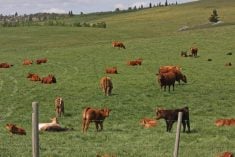Al Slinkard knows what farmers should have grown last summer – Maple peas.
They are selling for $16 a bushel right now, the University of Saskatchewan crop professor told growers at the Saskatchewan Herb and Spice Association during Crop Production Week.
The peas are prized in Great Britain, where they are fed to racing pigeons. But if farmers didn’t grow the peas last year, it’s too late.
“I can tell you it won’t be that price next year,” Slinkard said.
In a talk that ranged from new crop ideas to novel uses for old crops, Slinkard always came back to the bottom line.
Read Also

Know what costs are involved in keeping crops in the bin
When you’re looking at full bins and rising calf prices, the human reflex is to hold on and hope for more. That’s not a plan. It’s a bet. Storage has a price tag.
“You need to find a market to make it pay.”
For growers of herbs and spices, he suggested they look at crops for the birdseed market such as sunflowers, canaryseed, hemp and niger seed.
Other plants that offer a chance to make money, but only once buyers are confirmed, are native grass species for regenerating land, anything grown organically, and plants grown for their lignin content, such as dandelion roots, Jerusalem artichokes and flax.
Lignins are useful in diets since the non-soluble fibres fill people up without adding weight. The lignins can also be broken down into simple sugars that could compete with corn for use as a sweetener in beverages.
Dandelions are Wanda Wolf’s favourite plant. The Phippen, Sask., herb broker had a contract last year to supply dandelion roots for a coffee company to make a beverage blend. However, the drought hurt even the weed and she couldn’t get enough to fill the need. She is still interested in digging dandelion roots this year. The best source is organic farms because of the demand for chemical-free dandelions.
Wolf said she is also growing stinging nettle and oats, and noted that 75 percent of the herb buyers she works with want organically grown products.
The caution flags were out everywhere at the seminar. Buyers and researchers warned farmers to make sure they have a market before seeding unusual crops. They also encouraged farmers to try to get organically certified and to start with a small acreage.
Coriander and caraway prices have been good the past two years, which might mean a dip is coming this year if farmers respond by producing a lot of the pungent spices, said grower and broker Shaun Moran of Portage la Prairie, Man.
These two crops tend to be grown around the world, so prairie growers have a lot of competition.
However, there are a couple of positives. Since the United States has no subsidies on these crops, Americans don’t tend to grow them, even though the U.S. is one of the biggest importers of caraway.
Another Canadian advantage is food safety. Moran said spices and herbs can be bought cheaper from Africa and Asia, but cleanliness is lower than prairie standards.
He described visiting a British spice processor and seeing two rat turds in a one pound sample of fennel. The spice had been bought in India and cleaned once. He said after it was cleaned again, the screenings would probably be ground and sold as powdered spice, feces and all.
Price fluctuations are common for herbs and spices.
“In the past 20 years I’ve seen caraway prices from 20 cents a lb. to $1.30,” Moran said.
This month, cleaned caraway is selling for 70 cents per lb. in Western Canada.
He said herb and spice growers “have to have the guts to hold the seed for years” until prices improve.
The U.S. Department of Agriculture’s new National Organic Program and tougher European rules expected by 2005 are also causing complications.
Debbie Miller, a Lisieux, Sask., organic grower and president of an organic certification agency, said she suspects the Americans will be strict to begin with.
“Some of what I am going to tell you (about the NOP rules) is not logical, but the reality is, if we want to sell our products into the U.S., we have to follow them.”
As an example, she said the regulation on making compost requires that producers document their temperature readings and nitrogen content of compost they make to spread on organic fields.
“A five-year-old pile of manure is not compost if you haven’t turned it or had records of testing it. Under NOP, all you have is raw manure, not compost.”
She said the NOP insists that organic fields and pastures be fenced with posts that have not been treated with arsenic, and that potting soil for organic transplants be checked to ensure it does not contain unacceptable elements. Even ingredients used to make organic products, such as vegetable oil, should be checked with the manufacturer to ensure it is not corn oil, most of which is genetically modified.
Miller said organic farmers are going to be “wallowing deep” in government regulations.














